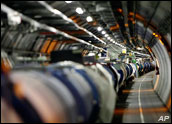
While it has been rumored for some time, Google announced Sunday is has been testing self-driving cars. The company equipped six Toyota Priuses and an Audi TT with technology that enabled a vehicle to drive from Google’s Mountain View, Calif., campus to its Santa Monica office. It then moved on to Hollywood Boulevard. In all, Google has sent its auto-cars more than 140,000 miles — including along the Pacific Coast Highway and across the Golden Gate Bridge.
Google notified local police of its testing program and insisted there was a clean-record driver in each vehicle ready to take over if the robot technology decided to go rogue. That may not always have been the case, though. At least one driver claims to have caught a Google car driving unmanned and posted a video on YouTube to prove it.
The Google cars use video cameras, radar sensors and a laser range finder to “see” other traffic. The cars also utilize detailed maps, which Google has gathered using manned cars. Fifteen engineers worked on the project, including some from DARPA Challenges, a group that runs a series of autonomous-vehicle races organized by the U.S. government.
Safety and Energy Efficiency
The goal of the project is driver safety and energy efficiency.
More than 1.2 million lives are lost every year in traffic accidents, according to the World Health Organization. That number could be cut by as much as half through the use of self-driving cars, suggested Google.
Productivity is another issue. The average daily commute is 52 minutes, noted Google — time that could be spend doing other things once operating a vehicle is taken out of the equation.
Furthermore, a car run by robotics would not be subject to dangerous driving behavior such as distracted driving, the company pointed out. So far, the only mishap the self-driving car has encountered was getting rear-ended at a traffic light.
“There are many ways this technology can help in terms of driver safety, including letting the driver know of danger ahead,” Azita Arvani, principal of the Arvani Group, told TechNewsWorld. “This technology can be used to fill in the gaps in driver error.”
The impact of creating a safer car could trump all other concerns in self-driving technology.
“People are increasingly distracted while driving. Having a car that could take over and keep you from having an accident could save your life,” Rob Enderle, principal analyst at the Enderle Group, told TechNewsWorld. “Google is doing very important work.
How Do You Monetize It?
There is no obvious profit in Google’s investment in self-driving cars, but the technology could potentially be licensed to the automotive industry.
Even an optimistic view puts the technology eight years away from deployment, though.
“Monetizing it is the trouble,” said Enderle. “Google is having trouble spelling the word ‘focus.’ They could use these self-driving cars to help them keep their location-based technology up to date, but that’s a real stretch in monetizing it.”
Robot at the Wheel
At the heart of the self-driving technology is robotics, and advances in robotics could be a road to profit, observed Laura DiDio, principal analyst at ITIC.
“The greater story here is that Google is at least flirting with robotics,” she told TechNewsWorld. “The self-driving car is just one application of robotics, and robotics is now where the PC industry was 35 years ago.”
Robotics are beginning to appear in a wide range of applications, from helping to plug the Gulf of Mexico oil leak to highly delicate surgery, to drones flying over Afghanistan.
“Robotics are all over land, sea and air,” said DiDio. “Microsoft has a large robotics research program. Now Google is dipping its toes into robotics. That’s the takeaway here.”





















































